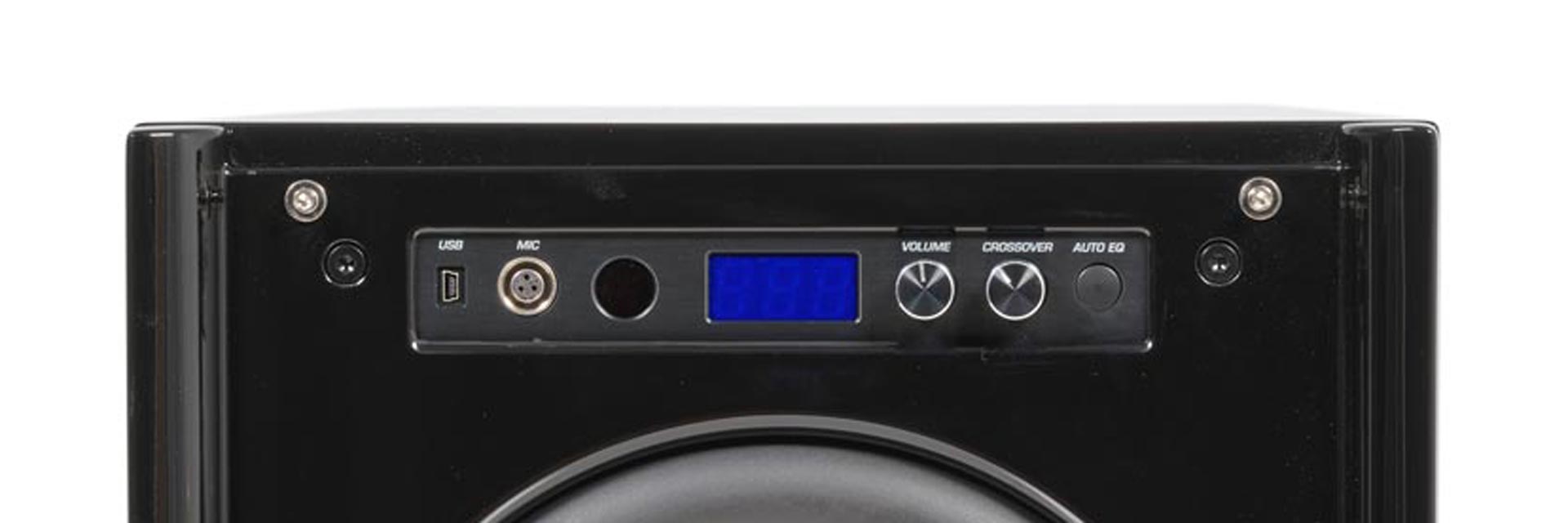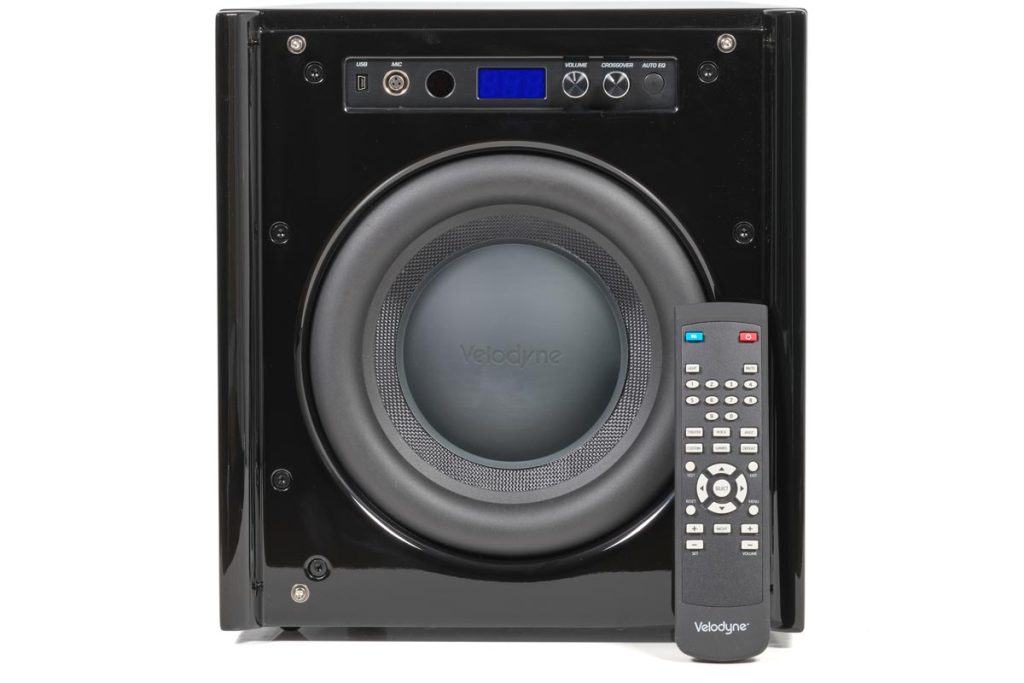We’ve just painstakingly set up two speakers correctly: the stage, tonality – everything is spot on. Yet, it still doesn’t sound quite real. Deep down in our consciousness, we know that audiophile bliss is incomplete without a subwoofer. But do we really want to put up with all the hassle? Dealing with the placement, and the phase, and the volume level, and the crossover frequency? Yes, we do – and no, there’s no need to be afraid.
By now, it’s well-established that a subwoofer in a stereo system isn’t necessarily about “more powerful” bass. Sure, having more (or better: deeper) bass is one use case. A pair of compact speakers can potentially provide a better defined sound stage thanks to their smaller baffle dimensions than floor-standing speakers can. When supplemented with a subwoofer, there’s no need to compromise on bandwidth either. However, even if the main speakers can reproduce the entire frequency spectrum, subwoofers have the potential to turn a good system into a great one, and there are several reasons for that.
The first reason is that when positioning your speakers in a room, you’re pursuing two different objectives that aren’t necessarily compatible: precise soundstage and bass performance that’s both full and clean. It’s usually possible to find a good compromise even without a subwoofer. However, a subwoofer offers a distinct advantage because you can optimize the placement of the main speakers solely for the best soundstage and leave filling in the missing bass to the subwoofer.
The second, perhaps even more crucial reason, is that subwoofers can dramatically improve spaciousness. This may sound counterintuitive since bass frequencies are omnidirectional by nature. However, bass plays a central role in conveying room information from which our brain derives the dimensions of the soundstage. For this to work, it’s necessary to ensure that the subwoofer and speakers complement each other effectively. This is where many people encounter difficulties. Adding a third sound source already increases system complexity, and then there’s the matter of level, phase, and crossover frequency adjustments. Some people give up at this point, despite the fact that the benefits of a subwoofer are hard to deny, even in a full-range system. Don’t worry, though – with the right approach, setting up and configuring a subwoofer is a manageable process. Once you’ve heard a properly functioning subwoofer setup, you won’t want to go without it.
Should We Add One More?
First and foremost, let’s address the quantity question: Is a single subwoofer sufficient to complement two speakers adequately in a stereo system? The answer is a conditional yes. In most recordings, bass frequencies up to about 200 Hertz are equally distributed to both channels. Since the wavelengths in this range are in the same ballpark as typical room dimensions, it doesn’t matter much whether the signal comes from one or two sources. Multiple subwoofers are usually used to achieve a more even distribution of bass energy in the room, which is especially important when the soundstage needs to work in different parts of the room. However, there are some exceptions, especially in acoustic and live music recordings, where both channels often carry different bass signals. In these cases, a single subwoofer can indeed be counterproductive, as the summation of signals onto one channel typically results in phase-related cancellations, effectively filtering out room reverb information – which is the exact opposite of what we’re aiming for. Setting up multiple subwoofers is more complicated than a single subwoofer setup, but let’s focus on one subwoofer here. If you have two, the adjustment process is essentially the same, with each subwoofer set to half the volume. The crossover frequency should be the same for both, while the phase may vary depending on the placement.
The Subwoofer Crawl
The goal when positioning subwoofers is to place them in a way that effectively and evenly excites the room. This is where room modes come into play, which are standing waves that occur at frequencies whose wavelengths are integer multiples of the room dimensions. These modes lead to significant peaks and dips in bass levels at different locations in the room. The beauty of these room modes is that they are symmetrical. Peaks and nulls that occur at the listening position are mirrored at the origin point of the bass signal. You can use this fact to find the right subwoofer placement – simply swap places with the subwoofer.
Before you begin, it’s a good idea to close the curtains to shield yourself from bewildered glances from your neighbors. Once you feel safe, place the subwoofer at the listening position, set the phase on the control panel to zero, and set the crossover frequency to the highest possible value. Adjust the level to about half of the maximum, and play a track that preferably has a melodic bass line. A CD player with an A-B repeat function is useful here, allowing you to loop a representative passage continuously. Now, get down on all fours and move your head to various positions where the subwoofer could potentially be placed. You’ll notice that the bass response varies significantly at different locations in the room. In some spots, the bass may sound boomy, and all notes seem to blend into one. In other areas, you’ll find that the bass is just right – deep, clear, and distinct, with no muddiness. Mark these positions with a piece of masking tape – this is where the subwoofer should go. You can get creative in marking positions as you explore your listening space. The classic placement is in one of the front corners, but a subwoofer can also deliver good results when placed on the sides or even behind the listening position. Choose the most inconspicuous location among all the marked spots. For two subwoofers, select two symmetrically positioned locations in the room – diagonally opposed is a good option.
…But What About Phase?

At this point, the subwoofer is in a position that interacts well with the inevitable room modes. The next question is whether its bass output complements your main speakers effectively. For this reason, most subwoofers offer a phase adjustment option. This might be a simple toggle switch that inverts the phase, while high-end subwoofers often have a continuous phase control. It’s important to note that the phase control can’t send the bass signal into the near future but can only delay it. Therefore, it’s recommended to place the subwoofer as close to the listening position as possible, such as along one of the side walls. If it’s positioned in a corner behind the main speakers, you can still set the phase correctly, but the bass will lag behind the music by at least one cycle.
If your subwoofer has a polarity inversion switch, you can perform a simple test to determine whether the signals from the subwoofer and speakers add up correctly. If you hear a cancellation in the crossover region when you reverse the phase, it indicates that the energy radiated by the subwoofer with the phase unaltered fully sums with the sound at the listening position. If you hear a significant boost instead, it means the subwoofer’s signal is arriving out of phase with the speakers at the listening position. In that case, leave the phase reversed.
The third and final scenario is when flipping the phase switch makes little to no noticeable difference. This indicates that the subwoofer and speakers at this position don’t effectively complement each other. In this case, it’s best to place the subwoofer at a different location than the ones initially marked – the goal is to find a spot where the difference between inverted and non-inverted polarity is as big as possible. In the correct position, the gears mesh correctly in the louder setting, and the bass signals effectively add up. If your subwoofer has a continuous phase control, this becomes much easier. Set the phase to the position where the bass is loudest – in this setting, the full bass energy is delivered to the listening position, and the subwoofer doesn’t have to work excessively.
Now, Let’s Make It Disappear
The most common and obvious mistake in subwoofer setup is configuring it to audibly generate additional bass. An old acoustician’s wisdom says that beginners set the subwoofer 12 decibels too loud, while professionals only set it 6 decibels too loud. It’s correctly set up when you can’t tell it’s there at the listening position. You’ll know everything is set up correctly when turning off the subwoofer doesn’t upset the tonal balance but rather makes the soundstage seem to collapse. To reach this point, you need a reference track that ideally doesn’t contain prominent bass. This might not be intuitive, but it has its reasons. Bass content varies significantly from recording to recording, making it challenging to find a meaningful reference based on bass alone. Furthermore, when adjusting the subwoofer, you should focus not on the bass but on the overall soundstage and tonality. The best way to do this is with vocals.
The art here is to find the right interaction between the crossover frequency and the level. Choose a high-quality recording with centrally placed vocals and minimal accompaniment. My recommendation is “Tenderly” by Dianne Reeves in a duet with Joe Williams (The Grand Encounter). Here, you have a female and a male voice covering different pitch ranges. Set the crossover frequency initially 10 Hertz above your main speakers’ lower frequency limit. If your main speakers can reach down to 40 Hertz at minus three decibels, 50 Hertz is a good starting point. Then adjust the level so that both voices sound natural, full-bodied, and present at the listening position without sounding thick or oversized. Once you achieve this, you’ve found the right level. Now comes the trickier part: searching for notes that stand out.
If the track plays cohesively throughout its duration, you’ve immediately found the correct crossover frequency, and you can congratulate yourself on a properly tuned subwoofer. However, more often than not, this won’t be the case. Some specific notes may sound weak, while others might seem overly pronounced. Adjust the crossover frequency to address these issues. If certain frequencies stand out too much, raise the crossover frequency; otherwise, lower it until the recording plays tonally consistently. This completes the setup. Now, adjust your favorite chair, insert one of your favorite recordings, and simply enjoy the music – you’ve earned it.


